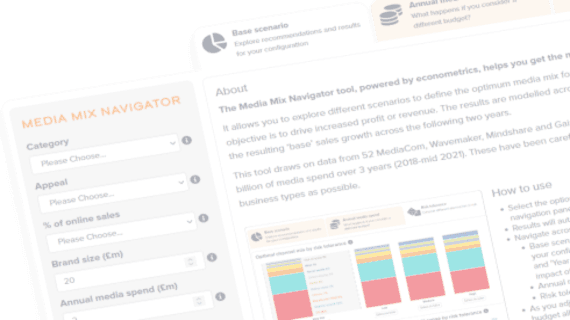In Brief
Demand Generation builds upon our multi-award winning study, Profit Ability: the business case for advertising, demonstrating how marketers can maximise short-term return without sacrificing sustained growth.
Whilst Profit Ability provided the hard data to support a more evidence-based approach to marketing effectiveness, our latest work - in conjunction with Mediacom, Wavemaker and Gain Theory – reveals the most effective, and practical, routes to profitable planning. What media decisions need to be made? What is the impact of these decisions on measurement? What are the trade-offs that marketers must make between speed of return, base-sales growth and risk?
Crucially, this study has isolated the key variables that impact advertising effectiveness. In turn, the data has been used to power The Media Mix Navigator. This optimiser tool enables marketers to determine the optimal media mix specific to their business and its objectives. It’s been specifically developed to help advertisers without their own econometric analyses to maximise their media-driven returns.
Key findings
The research draws on an econometric analysis of over £1.4 billion of media investment from 50 brands across 11 media from the last 3 years. It is one of the biggest studies of its kind to date.
The main findings revealed that:
Some forms of advertising are riskier than others
- The variability of returns differs significantly across different forms of advertising.
- Linear TV advertising and broadcaster VOD (BVOD) are the least risky forms of advertising whilst online display, cinema, social media and print all sit at the riskier end.
Most advertising channels boost the efficiency of others, but the scale and consistency of the effect differs significantly
- TV generates the highest ‘multiplier effect’ across all other channels.
- TV boosts the performance of other media channels used in a campaign by up to 54%, compared to around 8% across all other channels.
Marketing budgets tend to be used to do two things: demand generation & demand fulfilment.
- Both play an important role but demand generating activity is the principle means of driving business growth.
Within the first fortnight of a campaign, TV delivered on average 23% of media driven sales.
- This is the highest of any pure demand generating channel, the next best is print with 10%.
- Generic search, which straddles both ‘demand generation’ and ‘demand fulfilment’ and is TV’s natural partner, delivered an average of 29% of media-driven sales within two weeks.
- Due to the sustained effect of advertising, during the first 6-12 months, TV goes on to deliver a further 2.4 times more sales than it generated in the first two weeks of activity. This is significantly higher than any other media.
We need to put measurement right
- Measurement is not a problem in itself, but increasingly, marketers are measuring the wrong things.
- This is driven by partial reporting, limited post-campaign analysis, a reliance on ‘fast’ data and measuring what we want to know, not what we need to know in order to make the most profitable media decisions.
In depth
Background
After the success of Profit Ability, we were left with several unanswered questions. How can we add more breadth and depth to the data to translate the findings into practical, tangible guidelines that will be more relevant to advertisers? How can businesses optimise for short-term impact without damaging their sustained growth? How do different channel mixes impact on effectiveness?
Ultimately, we needed to build on the existing body of evidence to create a best-practise guide for both planning and measurement.
Methodology
We enlisted the help of Mediacom, Wavemaker and Gain Theory. Drawing on an extensive database of econometric models for 50 clients, spanning 14 product categories and 11 different media types, the data accounted for a whopping £1.4 billion of advertising across three years. Of these, six categories were isolated for analysis: FMCG, finance, retail, online retail, automotive and travel.
The breadth of brands enabled the analysts to capture nuances within the data that we’d been unable to see before, such as the difference between nice and mass brands, those that were high versus low interest and one-off purchases versus subscriptions.
To date, it is one of the largest studies of its kind in the world and the data fuelled the Media Mix Navigator optimisation tool, mentioned above.
Methodology film
Findings
Advertising can be separated into two types of activity: demand generation & demand fulfilment.
Media that generate demand tend to target more broadly and widen the potential pool of customers. Those that fulfil sales, harvest the demand from those people who are already in market.
Both play an important role but demand-generating activity is the principle means of driving business growth. The more people that know a brand, the more likely they are to buy.
Some forms of advertising are riskier than others
The research found that the variability of returns differed significantly across each advertising format. By removing the top and bottom quarter of returns across each campaign (to give an interquartile range) and analysing the middle 50%, the predictability of each media’s ability to a deliver return could be predicted.
The variability of returns differed significantly across the different forms of advertising.
Online display, cinema, social media and print delivered a greater level of risk, all having a variability of +/- 60% vs. the median return.
Linear TV advertising and BVOD, on the other hand, were found to be the least risky forms of advertising with a variance of just 20% versus the median return.

Most channels boost the efficiency of others, but the scale and consistency of the effect differs significantly
TV made other media work harder by boosting the performance of the other media channels used in a campaign by up to 54%. This is called the ‘multiplier effect’. TV had by far the highest multiplier effect of any media channel.
This is because TV is an audio-visual medium that acts as the narrative spine of a campaign. It therefore lingers in people’s memories.
Most media had a multiplier effect. Print was one of the most effective, boosting other channels’ performances by up to 13%. The average across all channels was 8% showing that all media formats work in harmony and campaigns are best planned in a synergistic manner to optimise the multiplier effect.
Within the first fortnight of a campaign, TV delivered on average 23% of media driven sales
Generally, it appeared the media channels which could be deployed the most quickly delivered the greatest level of response within the first two weeks of a campaign, but the volume they generated tended to be smaller.
When taking into account both the short-term and the sustained effects of media, TV was the highest of any pure ‘demand-generating’ channel. TV delivered 23% of sales that occur in the first fortnight of a campaign whilst the next best ‘demand-generating’ media was print with 10%. Overall TV delivered the highest proportion of media driven sales of any channel and significantly more of those in the longer term.
Generic search, which both generates and fulfils demand, is a natural partner for TV. Paid generic search delivered an average of 29% of sales that happen within two weeks.

We need to put measurement right
Measurement itself is not a problem, but increasingly, marketers are measuring the wrong things. Advertisers are making decisions based on partial reporting, limited post-campaign analysis and a reliance on ‘fast’ data. Often, the metrics that are tracked show activity in the best light rather than exploring the potential areas for improvement. Measurement is also rarely conducted for long enough giving false impressions of effectiveness, whereas the majority of advertising-based sales tend to happen long after a campaign has finished.
Advertisers need to:
- Define success in advance – work out how a campaign will be tracked, and for how long, before it goes live.
- Treat every channel alike thinking about inputs (such as spend), outputs (click, calls etc.) and the specific outcomes that the campaign was intended to generate (such as sales, web visits, market share).
- Know the fundamentals of the campaign across each media, such as cost per thousand, viewability and advertising context.
- Use the right methodology for the task in hand. There is not one method that comes close to doing everything! Although it’s tempting because it’s easy, advertisers, must resist the urge to use partial methods, like digital attribution, to measure holistic challenges, such as brand growth.

- Strike a balance between KPIs and the methodologies used to measure them to achieve consensus from multiple sources rather than relying on one or two data sets.
- Be honest and realistic about what can be measured and delivered in each time-frame. Long-term impact can’t be measured after just a few weeks!
- Be choosey about what is measured and don’t succumb to death by data – just because something can be measured it doesn’t mean that is should.
- Allocate budget towards testing. Be prepared to test, fail and learn.
- Things won’t stay the same forever. Use human judgement to review measurement approach regularly and adjust for any changes affecting a category or brand.
In summary
This project provides the industry with the broadest view of media performance to date. It goes under the bonnet of what factors drive the optimal plan for a brand, with the Media Mix Navigator helping to tailor the result specifically for individual brands.
 Thinkbox
Thinkbox
